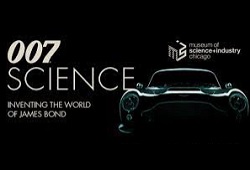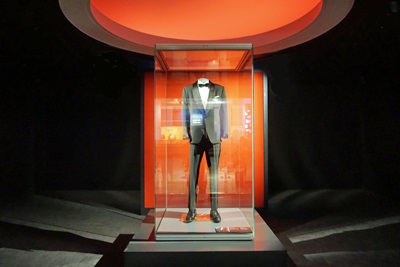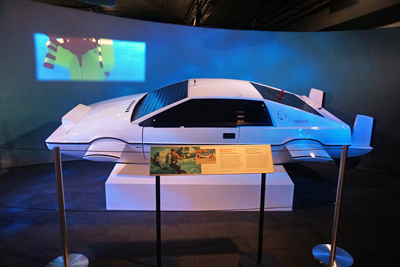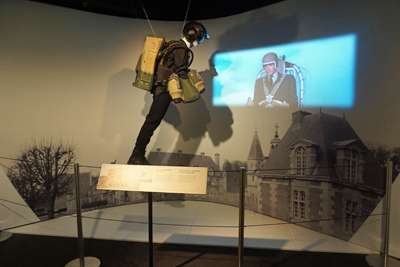
Science isn’t something that comes to mind while watching a James Bond film. Between the exotic locales, elaborate chase scenes, cunning espionage, and non-stop action, science inevitably gets lost in the mix. Yet a James Bond film is just as much about science as it is adventure and thrills, from the production of the films themselves to the gadgets invented by Q Division to the specially outfitted cars that conceal weapons and turn into submersible submarines.
In March 2024, the Museum of Science and Industry in Chicago brought science to the forefront of the Bond experience with 007 Science: Inventing the World of James Bond, a special exhibit scheduled to run through the end of October. “It’s about creativity, ingenuity, scientific principles, and it also shows the development of technology over time,” director of collections Kathleen McCarthy explained to WTTW News of 007 Science. “When you can bring it together through the lens of popular culture, it provides an access point that makes it easy for people to get excited, understand it and then retain it.”
The exhibit begins with the pre-production work necessary to bring any James Bond film to life. A plot needs developed with a villain who is not only a threat but is reflective of the times. While such narratives are constructed using one’s imagination, various scientific experts and engineers ultimately need consulted to ensure that the science in the films is realistic and the various chase scenes and stunts feasible. Storyboards are then drawn and miniaturized set pieces built in order to fully visualize the world of James Bond.
As the 007 Science exhibit points out, that world may not necessarily be in step with contemporary technology, as James Bond has often foreshadowed developments in various scientific fields, making each installment a window into the future. The chief technician in charge of outfitting Bond with his unique assortment of gadgets – simply named Q – is often seen working in his lab, testing his futuristic inventions in ways similar to real life scientists and engineers.
Various accessories are also designed to overcome real-world obstacles. When James Bond is sent to Eastern Europe during winter in The Living Daylights, his vehicle is equipped with ski-like outriggers and studded tires to help Bond navigate through the snow-and-ice terrain. The 007 Science exhibit not only notes Q’s modifications but dissects how and why these additions keep James Bond safe in even the most treacherous of conditions. The science of metal detectors, x-rays, bionic limbs, and even boats are all likewise explored in 007 Science.
In terms of gadgets, one of the most infamous on display at the Museum of Science and Industry is the gold gun used by assassin Francisco Scaramanga in The Man with the Golden Gun. The weapon itself is featured as well as an examination of the various components used to construct it. The barrel, for instance, is a fountain pen, while the handle is a cigarette case. A lighter is then used to connect the barrel and handle. A simple cufflink, meanwhile, serves as the trigger.
007 Science also contains a collection of real-world spy gadgets similar to those used by James Bond. Miniaturized cameras hidden in fountain pens and vest pockets, wristwatches capable of receiving data from undercover operatives, concealment containers for undeveloped film, a two-way radios disguised as cigar box, the insole of shoe capable of hiding a dagger, and actual CIA surveillance equipment from the 1970s are all display, courtesy of the International Spy Museum in Washington, D.C.
A handful of real-world spies, meanwhile, share their personal “Bond Moments” within the exhibit as well. “After a (Bond) movie opened, we’d sometimes get a call asking, ‘can we do that?’” Jonna Mendez, who worked at the CIA’s disguise department, recalls. “Often it was the beginning of us building something new.” Former CIA operative Valerie Plame, meanwhile, remembers using a “brush pass” on a busy European street – her and another agent carried similar briefcases, swapping them unnoticed after “accidently” bumping into each other.
During the late 1950s, Bell Aerosystems developed a “Bell Rocket Belt” that was in essence a jetpack. The fact that it required five gallons of fuel for a mere twenty-second flight – coupled with safety concerns – deemed it inoperable by the United States Army. James Bond nevertheless wore the device in the 1965 film Thunderball.
Close to sixty years later, the 007 Science exhibit at the Museum of Science and Industry featured a fully-functioning Jet Suit developed by Gravity Industries – demonstrating the ways that the fictional James Bond and the factual world intersect, not only during the time of each film’s release but well into the future as well.
“The exhibition immerses guests in creativity and resourcefulness,” director of collections Kathleen McCarthy told Forbes. “Ordinary objects take on extraordinary properties and the seemingly impossible becomes possible using science and engineering to solve challenges. We hope guests are inspired to see their world in a new light, full of possibility and are inspired to use their ingenuity to solve pressing challenges in their lives, their communities and the world.”
A walk through the 007 Science exhibit also makes one anxious for the arrival of the next James Bond film, not just for the inherent escapism but for a glimpse into the scientific wonders of the not-so-distant future as well.
Anthony Letizia





